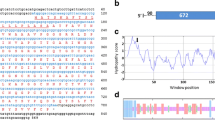Abstract
We report the isolation and characterisation of a wound-induced cDNA designated AoPR1 from a suspension of mesophyll cells that had been mechanically isolated from cladodes of light-grown Asparagus officinalis seedlings by grinding in a mortar and pestle. The transcript abundance is up-regulated following cell separation and in chopped mesocotyl tissue from dark-grown seedlings. The expression of AoPR1 was shown by northern analysis to be located around the site of damage. Sequence analysis revealed similarity between the predicted AoPR1 polypeptide and bean PvPR1 and PvPR2 proteins, the potato pSTH2 protein, the pea PI49 protein, the parsley PcPR1-1 protein and a major pollen allergen from birch (BetvI). These transcripts have been shown to be induced in response to microbial attack or fungal elicitation. To our knowledge, this is the first example of a monocot cDNA belonging to this class of intracellular pathogenesis-related proteins (IPRs).
Similar content being viewed by others
References
Bol JF, Linthorst HJM, Cornelissen BJC: Plant pathogenesis-related proteins induced by virus infection. Annu Rev Phytopath 28: 113–138 (1990).
Breitender H, Pettenburger K, Bito A, Valenta R, Kraft D, Rumpold H, Scheiner O, Breitenbach M: The gene coding for the major birch pollen allergen BetvI is highly homologous to a pea disease resistance response gene. EMBO J 8: 1935–1938 (1989).
Collinge DB, Slusarenko AJ: Plant gene expression in response to pathogens. Plant Mol Biol 9: 389–410 (1987).
Davis KR, Hahlbrock K: Induction of defence responses in cultures of parsley cells by plant cell wall fragments. Plant Physiol 85: 1286–1290 (1987).
Devereux J, Haeberli P, Smithies O: A comprehensive set of sequence analysis programs for the VAX. Nucl Acids Res 12: 387–395 (1983).
Dixon DC, Cutt JR, Kessig DF: Differential targetting of the tobacco PR1 pathogenesis-related proteins to the extracellular space and vacuoles of crystal ideoblasts. EMBO J 10: 1317–1324 (1991).
Dixon RA, Jennings AC, Davies LA, Gerrish C, Murphy DL: Elicitor-active components from French bean hypocotyls. Physiol Mol Plant Path 34: 99–115 (1989).
Draper J, Scott R, Armitage P, Walden R: Plant Genetic Transformation and Gene Expression: A Laboratory Manual. Blackwell Scientific Publications, Oxford (1988).
Fristensky B, Horovitz D, Hadwiger LA: cDNA sequences for pea disease resistance response genes. Plant Mol Biol 11: 713–715 (1988).
Fritig B, Kauffmann S, Dumas B, Geoffrey P, Kopp M, et al.: Mechanism of the hypersensitive reaction of plants. In: Evered D, Harnett S (eds) Plant Resistance to Viruses, pp. 92–108. Ciba Foundation Symposium 133. Wiley, Chichester (1987).
Grosset J, Marty I, Chartier Y, Meyer Y: mRNAs newly synthesised by tobacco mesophyll protoplasts are wound-inducible. Plant Mol Biol 15: 485–496 (1990).
Gubler U, Hoffman BJ: A simple and very efficient method for generating cDNA libraries. Gene 25: 263–269 (1983).
Harikrishna K, Paul E, Darby R, Draper J: Wound response in mechanically isolated asparagus mesophyll cells: A model monocotyledon system. J Exp Bot 42: 791–799 (1991).
Higgins DG, Sharp PM: CLUSTAL: a package for performing multiple sequence alignments on a microcomputer. Gene 73: 237–244 (1989).
Kamer G, Argos P: Primary structural comparison of RNA-dependent polymerase from plant, animal and bacterial viruses. Nucl Acids Res 12: 7269–7281 (1984).
Kauffmann S, Legrand M, Geoffroy P, Fritig B: Biological function of pathogenesis-related proteins: four PR proteins of tobacco have 1,3-β-glucanase activity. EMBO J 6: 3209–3212 (1987).
Legrand M, Kauffmann S, Geoffroy P, Fritig B: Biological function of pathogenesis-related proteins: Four tobacco pathogenesis-related proteins are chitinases. Proc Natl Acad Sci USA 84: 6750–6754 (1987).
Matton DP, Brisson N: Cloning, expression and sequence conservation of pathogenesis-related gene transcripts of potato. Mol Plant-Microbe Interactions 2: 325–331 (1989).
Paul E, Harikrishna K, Fioroni O, Draper J: Dedifferentiation of Asparagus officianalis L. mesophyll cells during initiation of cell cultures. Plant Sci 65: 111–117 (1989).
Ryan CA: Oligosaccharide signalling in plants. Annu Rev Cell Biol 3: 295–317 (1987).
Sanger F, Nicklen S, Coulson AR: DNA sequencing with chain-terminating inhibitors. Proc Natl Acad Sci USA 74: 5463–5467 (1977).
Sambrook J, Fritsch EF, Maniatis T: Molecular Cloning: A Laboratory Manual, 2nd ed. Cold Spring Harbor Laboratory Press, Cold Spring Harbor, NY (1989).
Schmelzer E, Krüger-Lebus S, hahlbrock K: Temporal and spatial patterns of gene expression around sites of attempted fungal infection in parsley leaves. Plant Cell 1: 993–1001 (1989).
Somssich IE, Schmelzer E, Bollmann J, Hahlbrock K: Rapid activation by fungal elicitor of genes encoding ‘pathogenesis-related’ proteins in cultured parsley cells. Proc Natl Acad Sci USA 83: 2427–2430 (1986).
Somssich IE, Schmelzer E, Bollmann J, Hahlbrock K: Gene structure and in situ transcript localisation of pathogenesis related protein 1 in parsley. Mol Gen Genet 215: 200–208 (1988).
vanLoon LC: Stress proteins in infected plants. In: Kosuge T, Nester EW (eds) Plant-Microbe Interactions: Molecular and Genetic Perspectives, Macmillan, New York (1990).
Walter MH, Jian-Wei L, Grand C, Lamb CJ, Hess D: Bean pathogenesis-related (PR) proteins deduced from elicitor-induced transcripts are members of a ubiquitous new class of conserved PR proteins including pollen allergens. Mol Gen Genet 222: 353–360 (1990).
Author information
Authors and Affiliations
Rights and permissions
About this article
Cite this article
Warner, S.A.J., Scott, R. & Draper, J. Characterisation of a wound-induced transcript from the monocot asparagus that shares similarity with a class of intracellular pathogenesis-related (PR) proteins. Plant Mol Biol 19, 555–561 (1992). https://doi.org/10.1007/BF00026782
Received:
Accepted:
Issue Date:
DOI: https://doi.org/10.1007/BF00026782




